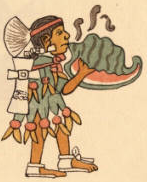Xochipilli (Chávez) on:
[Wikipedia]
[Google]
[Amazon]
 ''Xochipilli'', subtitled "An Imagined Aztec Music", is a short composition for four wind instruments and six percussionists by the Mexican composer
''Xochipilli'', subtitled "An Imagined Aztec Music", is a short composition for four wind instruments and six percussionists by the Mexican composer

 ''Xochipilli'' is scored for ten players: piccolo, flute, E clarinet, trombone, and six percussionists playing a variety of instruments, many of Aztec origin: ''
''Xochipilli'' is scored for ten players: piccolo, flute, E clarinet, trombone, and six percussionists playing a variety of instruments, many of Aztec origin: ''
 ''Xochipilli'', subtitled "An Imagined Aztec Music", is a short composition for four wind instruments and six percussionists by the Mexican composer
''Xochipilli'', subtitled "An Imagined Aztec Music", is a short composition for four wind instruments and six percussionists by the Mexican composer Carlos Chávez
Carlos Antonio de Padua Chávez y Ramírez (13 June 1899 – 2 August 1978) was a Mexican composer, conductor, music theorist, educator, journalist, and founder and director of the Mexican Symphonic Orchestra. He was influenced by nativ ...
, written in 1940. Its original title was ''Xochipilli-Macuilxóchitl'', which is the double name of an Aztec god in two of his aspects, meaning "Flower Prince" and "Five Flower".
History
In connection with an exhibition titled Twenty Centuries of Mexican Art, held in May 1940 at theMuseum of Modern Art
The Museum of Modern Art (MoMA) is an art museum located in Midtown Manhattan, New York City, on 53rd Street between Fifth and Sixth Avenues.
It plays a major role in developing and collecting modern art, and is often identified as one of ...
in New York City, the president of MoMA, Nelson Rockefeller
Nelson Aldrich Rockefeller (July 8, 1908 – January 26, 1979), sometimes referred to by his nickname Rocky, was an American businessman and politician who served as the 41st vice president of the United States from 1974 to 1977. A member of t ...
, commissioned Chávez to assemble a programme of music for daily presentation, under the title Panorama of Mexican Music. In addition to arrangements of popular Mexican music from the recent past, Chávez composed ''Xochipilli-Macuilxóchitl'' to showcase pre-Columbian Aztec instruments. This score was completed on 12 May 1940. Chávez conducted the premiere at the opening performance of the Museum of Modern Art exhibit four days later, on 16 May 1940.
In 1964 Chávez revised the score for publication. At this time he shortened the title to ''Xochipilli'', and added the (English) subtitle, "An Imagined Aztec Music".
Instrumentation

 ''Xochipilli'' is scored for ten players: piccolo, flute, E clarinet, trombone, and six percussionists playing a variety of instruments, many of Aztec origin: ''
''Xochipilli'' is scored for ten players: piccolo, flute, E clarinet, trombone, and six percussionists playing a variety of instruments, many of Aztec origin: ''teponaztli
A teponaztli is a type of slit drum used in central Mexico by the Aztecs and related cultures.
Structure
Teponaztli are made of hollow hardwood logs, often fire-hardened. Like most slit drums, teponaztlis have two slits on their topside, cut ...
'', '' huéhuetl'', ''omichicahuaztli''. The piccolo and flute deputize for Aztec flutes of bone or clay, the E clarinet represents the clay ocarina
The ocarina is a wind musical instrument; it is a type of vessel flute. Variations exist, but a typical ocarina is an enclosed space with four to twelve finger holes and a mouthpiece that projects from the body. It is traditionally made from c ...
, and the trombone is used as a substitute for the Aztec conch-shell trumpet.
Programme
In Aztec mythology, Xochipilli is the god associated with flowers, music, and dance, as is also Macuilxóchitl. "Their difference is esoteric. Macuilxochitl is the imperceptible god, an entity beyond the scope of human thought, a timeless being dwelling in the cosmos. Xochipilli is the embodiment of the same spirit on Earth, perceived in the visible, tangible, and edible world".Analysis
''Xochipilli'' falls into three main sections, b. 1–83, 84–134, and 135–269, in an ABA' pattern. The two outer sections are in fast tempos (Allegro animato, = 100, and Vivo, = 104), surrounding a slow central section (Lento, = 58). Each of these parts is in turn subdivided into three subsections.Discography
* ''A Program of Mexican Music: Sponsored by the Museum of Modern Art''. Blas Galindo (arr.), ''Sones de Mariachi''; Carlos Chávez (arr.): ''La paloma azul''; Carlos Chávez, ''Xochipili-Macuilxochitl'' and "Danza a Centeotl" (from ''Los cuatro soles''); Luis Sandí (arr.), Yaqui music; Gerónimo Baqueiro Fóster (arr.), ''Huapango''. Carlos Chávez conducting an orchestra of American and Mexican musicians and the chorus of the National Music League. Four-disc set, 78 rpm, 12 in. Columbia M-414 (set): 70332-D, 70333-D, 70334-D, 70335-D. New York: Columbia, 1940. * ''Mexico: Its Cultural Life in Music and Art / Su Vida Cultural en la Música y el Arte''. Carlos Chávez: "Danza a Centeotl" from ''Los cuatro soles''; ''Xochipilli''; Luis Sandi (arr.), ''El venado''; Carlos Chávez (arr.), ''La paloma azul''; Blas Galindo (arr.), ''Sones de mariachi''; Gerónimo Baqueiro Fóster (arr.), ''La bamba''. Mexican Orchestra and Chorus; Carlos Chávez, cond. LP recording, 1 disc, 12 in., 33⅓ in. New York: Columbia Records, 1964. * ''Carlos Chávez: Chamber Works''. ''Xochipilli: An Imagined Aztec Music''; Suite for Double Quartet, from ''The Daughter of Colchis''; ''Tambuco''; ''Energía''; Toccata for Percussion Instruments. La Camerata; Tambuco; Eduardo Mata (cond.). CD recording, 1 disc: stereo, 12 cm. Dorian DOR-90215. Troy, NY: Dorian Records, 1994. * ''Carlos Chávez: Complete Chamber Music'', Vol. 3. ''Xochipilli, an Imaginary Aztec Music''; Toccata for percussion; ''Cuatro melodías tradicionales''; ''Tambuco'' for percussion; ''Lamentaciónes''; ''Cantos de México''; ''Antígona, apuntes para la sinfonía''; ''Tres Exágonos''. ''Otros Tres Exágonos''; Partita for solo timpani. Southwest Chamber Music. CD recording, 1 disc: stereo, 12 cm. Cambria CD 8853. Lomita, CA: Cambria Master Recordings, 2005.References
* * * * * *Footnotes
{{Authority control Compositions by Carlos Chávez 1940 compositions Compositions for decet